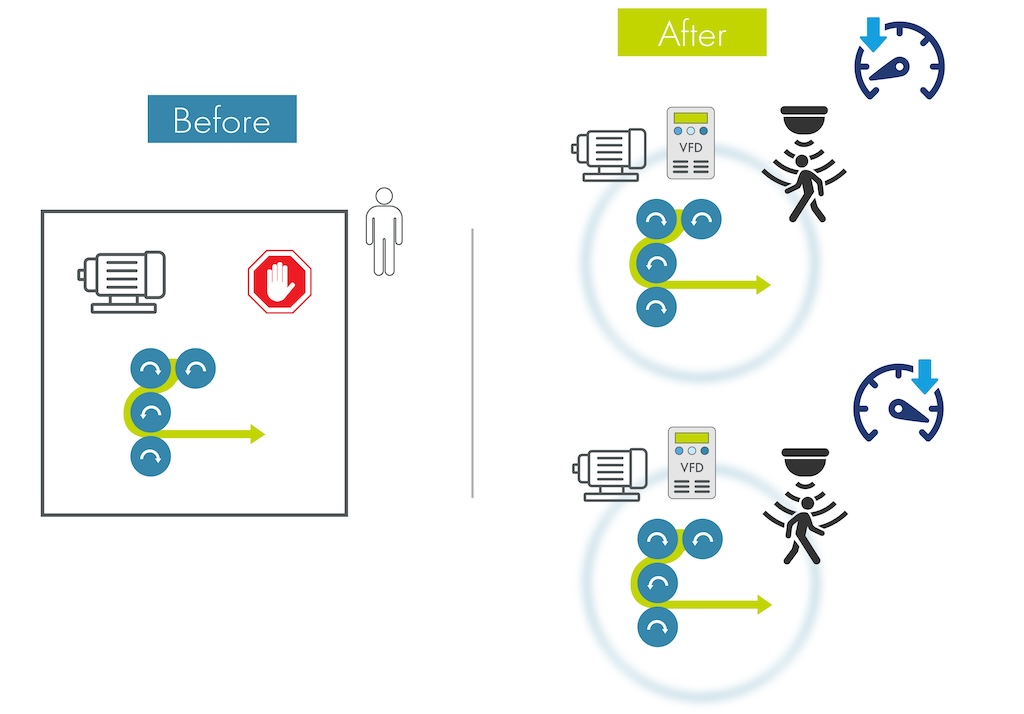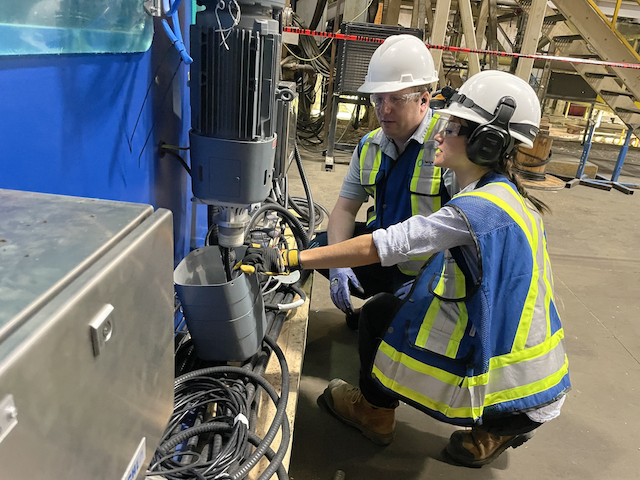Fans and blowers are simple pieces of equipment, yet require a lot of maintenance, particularly for bearings. The higher the speed, the more problematic they become. This article details how to avoid common problems caused by the improper selection of pillow block housings, seals, bearings, lubricant and lubrication systems.
POWER TRANSMISSION
HVAC
MAINTENANCE
Feature: Solutions to fan and blower bearing problems
Sidebar 1:
Starting cold fans
Sidebar 2:
Advantages of oil lubrication in fan bearings
Sidebar 3:
What oil mist does
Sidebar 4:
Preventing oil purge from pillow blocks
Nick Agius, Commercial Bearing Service, Ltd., Edmonton, AB, Canada
-
Proper pillow block and seal selection help avoid bearing problems.
-
Oversized bearings can be lightly loaded and fail.
-
Oil lubrication is preferred over grease for bearings.
Fans and blowers are simple pieces of equipment, yet require a lot of maintenance, particularly for bearings. The higher the speed, the more problematic they become. If all fans and blowers ran at 1200 rpm, their reliability would be very high; however, most run at 1800—3600 rpm or higher.
Many common problems are caused by the improper selection of pillow block housings, seals, bearings, lubricant, and lubrication systems.
Pillow block housings
Mountings or pillow blocks are available for most types of rolling element bearings. They are convenient and economical, and reduce the time spent selecting and preparing bearing elements, seals, and mounting methods. Mounted bearing units are available off-the-shelf and the only selection information necessary is shaft size, radial and thrust load, load characteristics, speed, and environment.
SAF and SAFD
The most popular styles for fans and blowers are SAF and SAFD housings ( Fig. 1 ). Although both designs accommodate oil lubrication, SAFD has a larger lubrication reservoir for shaft sizes greater than 31/4-in. dia.
Also, the SAFD design has a ductile iron body, which is preferred for fan service.
SNH and SNL
The SNH housing creates two major problems related to lubrication and sealing for fan service. Due to its shallow lubrication reservoir, it is only suited for grease service. The SNH block can work with oil if a recirculating oil system is used. The standard, G-type, contact seal causes too much heat at high speeds.
The SNL housing supersedes the SNH housing. All dimensions, parts, and performance remain the same.
Split-babbitt
Another common fan pillow block is the split-babbitt design. The most common complaint for this type is that the seals leak oil. This problem is caused by the location of the automatic oiler on the housing. This style of block is available with oil lubrication only.
All of the above pillow block styles are normally supplied for straight shafts. They use tapered bore bearings with adapter sleeves to mount the bearings correctly.
Stepped shafts are more expensive, but have the advantage of taking the human element out of bearing mounting. The millwright merely has to heat up the bearing and mount it on the shaft. No feeler gauges, charts, adjustments, or measurements are required. SAF, SAFD, SNH, and SNL pillow blocks are available with stepped shaft designs.
PDN
Some of the advantages of the PDN design ( Fig. 2 ) include a large oil reservoir, stepped shaft design, and simplified alignment. The PDN block can easily be modified to accept a labyrinth seal by machining the end plates.
Seals
Seals retain lubricant and exclude foreign matter. Application variables include temperature range, dynamic shaft runout, and shaft speed variation. Noncontacting seals do not generate heat and allow a small amount of lubricant leakage but do not wear. Contacting seals minimize leakage but cause shaft friction and seal wear.
Labyrinth
The standard seal for SAF and SAFD pillow blocks is the LER aluminum, labyrinth design. This noncontact seal doesn’t generate heat on the shaft and can handle high speeds. It is limited in its ability to seal in a dirty environment. An O-ring in the inner bore is particularly useful when using oil because it seals along the shaft.
These seals are available in a split design ( Fig. 3 ). There is little advantage to the split design unless it is used with a split bearing. The argument most maintenance people use to justify a split seal is the ease of replacement, but a seal should only have to be replaced if the bearing fails.
Split-lip
The standard seal for SNH housings is the G-type, split-lip. This design provides good sealing because of contact.
However, this contact creates shaft wear and much higher temperatures at high speeds and is the primary reason why this seal is not the best selection for a fan application.
Felt
A very common seal on older pillow blocks is felt, which has a surprisingly low shaft speed limit of only 800 fpm. Many of these seals are running much faster with no apparent problems, because the felt has worn back and doesn’t contact the shaft, thus preventing a heat build-up. At the same time, it is not providing much protection.
Bearings
Both double-row, spherical roller, and ball bearings are common in fan pillow blocks. They use tapered adapters with straight shafts to both mount the bearings and control internal bearing clearances.
Double-row, spherical bearings with tapered adapters are simple to mount and internal clearances are easy to adjust. These bearings handle higher loads than ball bearings, but are limited to lower speeds. The maximum speed should always be checked, especially if there have been repeated failures on a particular fan.
A problem with double-row, spherical roller bearings occurs when the fan load is not high enough and rollers skid, which can cause failure. Roller skidding can be avoided by properly sizing the bearing, and is determined by a detailed failure analysis. Bearing manufacturers can provide this service and other solutions to roller skidding.
Double-row ball bearings with tapered bores are the most difficult to set correctly because a feeler gauge cannot be used to set the proper clearances. The most common cause of failure is having the clearances totally taken out of the bearing at installation. The obvious 360-deg wear path around the outer ring is a certain indication of this problem.
Fixed and floating bearings
Most shafts have at least two bearings supporting them. It is advisable to fix only one bearing per shaft so that one is locked from axial movement while the other is allowed to float. This technique is critical on fans that run at high speeds or for bearings that are spaced more than 2-ft apart on a shaft.
When a shaft is rotating at high speed, it develops heat, causing it to grow axially. This axial growth places a load on both bearings if they are fixed in their housings. It is advisable to fix the bearing closest to the drive coupling or belt.
The one time this rule-of-thumb can be ignored is on belt-driven fans where the load is light. If the load is too light, balls or rollers can skid. One way to eliminate this problem is to fix the bearing furthest away from the belt drive.
SAF, SAFD, and SNH housings have fixing rings that can be added or removed to create a fixed and floating arrangement. This action sounds simple, but is often overlooked.
Lubrication
There are several lubrication factors that should be considered.
Grease
A major problem when using grease is the inability to analyze the condition and amount of usable grease inside the pillow block while the fan is running. The only way to check the grease is to shut down the fan and remove the top cap of the pillow block. This approach allows visual confirmation of the amount of grease and its condition.
Another problem is that anyone with a grease gun can add new lubrication. Each time grease is added, the amount should be recorded and logged so that all maintenance personnel are aware of what has been done.
As soon as new grease is added, bearing temperature rises for a short period of time. If enough isn’t added, the temperature rises for a long time. Once a year, the housing should be opened and excess grease removed. This removal ensures the buildup of old grease does not cause bearings to run too hot.
Oil
Using oil to lubricate fan bearings is clearly an advantage, especially at high speeds. If the running temperature of the bearings is still too high, there are some options that help deal with this problem.
Consider synthetic oils. These oils can run at much higher temperatures than standard grades. Standard oils can have a maximum operating temperature as low as 150 F. Some synthetic oils operate at maximum temperatures as high as 550 F. At these higher temperatures, the bearing becomes the weak link. Consult a lubrication specialist or supplier about the different synthetic oils available.
Install an oil system that lowers and controls the oil temperature. These systems are designed to deal with high temperature problems because they constantly supply new oil to the bearing.
Sight glasses and oil levels
A pillow block that is oil lubricated actually has two oil levels—static and dynamic. This situation is a result of the design of the pillow block and the drain hole positions. The direction of shaft rotation causes a slightly higher dynamic level than the static level on one side of the housing while the fan is running. Conversely, a slightly lower dynamic level than the static level appears on the other side.
This situation is a critical point to understand, to avoid adding too much oil and exacerbating the problem that is to be eliminated. The static and dynamic oil levels should be clearly marked. The difference between levels can be as high as 1/2 in.
Automatic oilers
Automatic oilers are ideally suited for use on most centrifugal pumps; however, their use on most styles of pillow block housings is questionable, because they can cause oil leaks.
The problem with automatic oilers on SAFD and SNH housings is the difference in dynamic and static oil levels. The oiler gives too much oil at startup or allows the oil level to sink too low before releasing oil, which might be too late to prevent failure.
Oil mist
Oil mist is an extremely good way to lubricate fan and blower bearings. It keeps the bearings both cool and clean. The major objection is cost. However, the cost of down time is much higher. Oil mist cost has come down over the past several years and the payback can be as soon as 1 yr.
Air cooling
Using air to cool the outside of a pillow block is the most common mistake made in the field. Air is directed to the outside of a pillow block in an attempt to lower the bearing temperature. The internal temperature increases, because the internal running clearance of the bearings is reduced.
Heat is generated inside the bearing and causes the shaft and inner ring to expand. Heat is then transferred to the outer ring and the pillow block housing, which causes them to expand. If the housing is cooled, expansion is restricted, causing more internal heat. If air is used, direct it toward the shaft, not the housing.
Temperature measurement
The type of temperature device selected is very important. If the temperature reading is not accurate, a solution may be sought for a problem that doesn’t exist.
Be careful when depending on noncontact, infrared, laser-sight thermometers for readings. The problem with most of these devices is that different surfaces have different emissivities. There are models that can be adjusted to solve this problem. Nothing beats a contact temperature device to prevent confusion.
Record all running temperatures on a regular basis for all fan bearings. It might seem a bearing is running hot, but if the file shows this bearing usually runs hot, then time and resources are not spent fixing a problem that doesn’t exist.
A good trick is to mark an “X” on the pillow block or housing so the temperature is always taken at the same location. This mark ensures consistency and accuracy of readings.
Shaft locking
Some lighter series of ball bearing pillow blocks use a set screw and collar to secure the inner ring to the shaft. This approach is not the best style of locking device for high-speed shafts. The bearing inner ring usually has a clearance fit to allow it to slide onto a ground shaft. When the set screw is tightened, the shaft is pushed off-center, causing the assembly to become unbalanced, which happens on both ends of the same shaft.
Another common device is the eccentric lock collar, which produces the same result as set screws.
A squeeze-lock design has a series of splits on the inner ring which, when the lock collar is tightened, allows the shaft to remain centered ( Fig. 4 ).
Pedestal and fan base construction
The base pedestal for pillow blocks should have a removable base under the housing that is bolted onto the main frame. Having a removable base makes pillow block replacement easier by allowing room to install components, such as bearing adapters and labyrinth seals. Without this feature, maintenance staffs must try to wrestle the whole assembly by sliding the housing and seals along the shaft. With this modification, a hydraulic nut can be used to assemble the bearings. This method is the most accurate, simplest, and quickest way to install a bearing.
When the shaft cannot be raised, having a removable base is an advantage. Thickness of the removable base depends on the size of the pillow block housing. As a rule-of-thumb, this thickness should be the same as the distance from the base to the center height of the housing being supported.
Spacer couplings should always be used on fans and blowers. If a spacer coupling is not used, the motor must be pulled off its base when a bearing replacement is required, which requires extra time. A large-motor re-alignment can take hours. If a spacer coupling is not used, split bearings should be used.
—Edited by Joseph L. Foszcz, Senior Editor,
630-320-7135, [email protected]
More info
The author is available to answer questions about fan and blower bearing problems. Contact him by e-mail at [email protected] . A more complete discussion of this topic can be viewed on the company web site at commercialbearing.com .
Sidebar 1: Starting cold fans
Build protection around the motor and fan bearings to reduce the winter wind chill factor. Many fan bearing failures are caused by the housing cooling and reducing the bearing running clearance.
When starting up a cold fan, run it and shut it down a couple of times before turning it over to operations. This approach generates heat in the inner ring. By this procedure, the outer ring and housing are given a chance to expand from heat transfer. Failure is caused by the bearings being damaged at startup from reduced clearances due to the cold housings that did not expand in time.
This condition seems to be more of a problem with grease lubrication than with oil lubrication, because cold grease does not lubricate as effectively as oil.
Sidebar 2: Advantages of oil lubrication in fan bearings
- Level and condition of the oil is always visible through a sight glass.
- Oil can be changed and samples taken without shutting down the fan.
- Pillow blocks run at slightly lower temperatures than those lubricated with grease.
- Bearings can run at higher speeds.
- Oil lubrication is better than grease in extremely cold applications. (Grease tends to stiffen and not slump into bearings at cold temperatures, depriving them of lubrication.)
- Oil lubrication is better than grease in minimum load conditions. Oil doesn’t resist rolling elements as much as grease.
Sidebar 3:What oil mist does‘s and don’ts of the plastic pipe installation process
- Provides an automatic, centralized system that continuously delivers fresh, clean oil to multiple, widespread machine elements.
- Improves safety, productivity, housekeeping, and lubrication.
- Closely approximates actual bearing requirements and reduces lubricant consumption by as much as 80%.
- Eliminates energy-wasting oil sumps. Reductions in power consumption of more than 25% are common.
- Often lowers bearing temperatures dramatically. Not by actual cooling, but because a power consumption reduction represents heat that is not generated in churning excess lubricant.
- Extends machine life by helping to exclude dirt and corrosive atmospheres with pressurized housings.
- Protects equipment on standby and in storage.
Sidebar 4: Preventing oil purge from pillow blocks
Double row, self-aligning bearings are commonly oil-lubricated when used on high-speed fan shafts. There is often a problem of oil leakage along the shaft. The leakage occurs at one end of the housing and may be experienced with any seal design. This problem is a result of the pressure differential across the housing caused by the flow of air. High pressure on the “windward” side and low pressure on the “leeward” side combine to force oil out along the shaft .
Eliminate this problem by installing a pressure equalizing tube. If both sides of the housing are connected, the internal pressure is equalized. This action eliminates the internal pressure driving the oil out.



